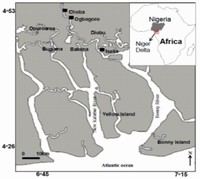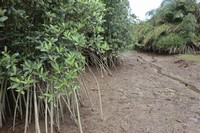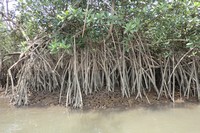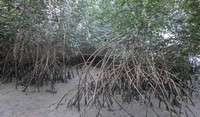Special Program for International Students
GRADUATE COURSE IN EARTH SCIENCE
& GEOENVIRONMENTAL SCIENCE
Current students





Nwawuike Nnawugwu (Nigeria)
Email: nwawuikennawugwu@gmail.com
Thesis title: Environmental risk assessment of geochemical composition and spatial dynamics in sediments of Niger Delta mangrove, Nigeria.
Supervisor: Professor Hiroaki Ishiga (2017-2020).
Mangroves are highly specialized ecosystems found between latitudes 30o north and south of the equator. They thrive in saline and brackish environments. Sediments in mangroves are mostly deposited under anaerobic conditions with high concentrations of sulfides and organic matter (Silva et al, 1990). As a sink, mangroves therefore fosters the retention of water-borne heavy metals. In the aquatic ecosystem, trace metals are among the most persistent pollutants (Arnason and Fletcher, 2003). The mangroves of the Niger Delta in Nigeria are the largest in Africa with estimated area coverage of 7,386km2 (UNEP, 2007). They are home to Global 200 Eco-region and harbors many locally and globally endangered species as well as about 60 - 80% of all plant and animal species found in Nigeria (UNDP, 2012; Okonkwo et al, 2015). The area has been the focus of hydrocarbon exploration and exploitation since 1937. Therefore, environmental degradation is high in many parts of Niger Delta due to pollution from oil related activities and industrial effluents.
Niger Delta evolved as a result of the drifting apart of the African and South American plates at the site of the triple junction in the late Jurassic and continued into the Cretaceous (Burke et al, 1971; Emujakporue and Ngwueke, 2013). The geologic sequence of the Niger Delta consists of three main subsurface lithostratigraphic units which are overlain by different types of Quaternary deposits ranging in age from tertiary to recent (Short and Stauble, 1967; Reijers, 2011). The lithostratigraphic units are the Benin Formation, Agbada Formation and Akata Formation.
This research focuses on the systematic analysis of the geochemical composition of the surface and core sediments as well as bioaccumulation in Rhizophora racemosa as a tool for the environmental risk assessment of the Niger Delta mangrove. The data obtained will be used to assess the toxic potentials of the sediments using contamination factor, enrichment factor, geoaccumulation index and pollution load index. The translocation of bioaccumulated metals will be determined using translocation factor. Potential ecological risk index and some established international sediment quality guidelines will be used to evaluate the potential toxic effects of heavy metal concentrations on the biota in Niger Delta mangrove. This study is expected to generate data on the concentration and spatial distribution of heavy metals in mangrove sediments in Niger Delta; produce data on the bioaccumulation and translocation of heavy metals in Rhizophora racemosa in Niger Delta and also highlight the present and potential ecological risks of heavy metal concentration in Niger Delta mangrove sediments. The data generated from the study will also be used for comparative analysis of heavy metal concentration in sediments of the Niger Delta and the Okinawa mangroves.
REFERENCES
Arnason, J. G. and Fletcher, B. A. (2003). A 40+ Year Record of Cd, Hg, Pb and U Deposition in Sediments of Patroon Reservoir, Albany County, NY, USA. Environmental Pollution, 123: 383 - 391.
Burke, K; Dessauvagie, T. F. J. and Whiteman, A. J. (1971). Opening of the Gulf of Guinea and Geological History of the Benue Depression and Niger Delta. Nature Physical Science, 233:51 - 55.
Emujakporue, G. O and Ngwueke, M. I. (2013). Structural Interpretation of Seismic Data from an XY Field, Onshore Niger Delta, Nigeria. Journal of Appl. Sci. Environ. Management, 17 (1): 153 - 158.
Okonkwo, C; Kumar, L; and Taylor, S. (2015). The Niger Delta Wetland Ecosystem: What threatens it and why should we protect it? African Journal of Environmental Science and Technology, 9 (5): 451 - 463.
Reijers, T. J. A. (2011). Stratigraphy and Sedimentology of the Niger Delta. Geologos, 17(3): 133-162, dio: 10.2478/v10118-011-0008-3.
Short, K. C. and Stauble, A. J. (1967). Outline Geology of Niger Delta. AAPG Bulletin 51 (5): 761 - 779.
Silva, C. A. R; Lacerda, L. D. and Rezende, C. E. (1990). Metals Reservoir in Red Mangrove Forest. Biotropica, 22 (4): 339 - 345.
UNDP (2012). Niger Delta Bioderversity Project. UNDP Project Document.
UNEP (2007). Mangroves of Western and Central Africa. UNEP-Regional Seas Programme/UNEP-WCMC.
